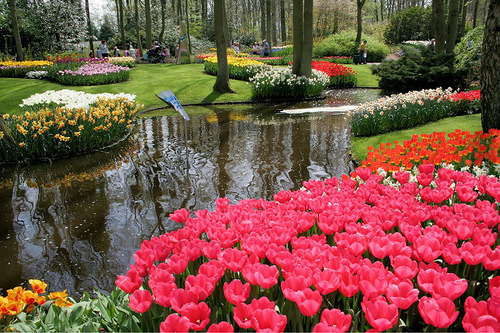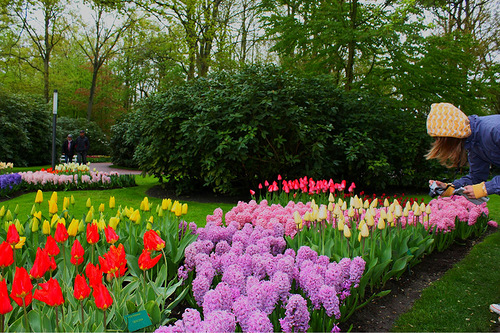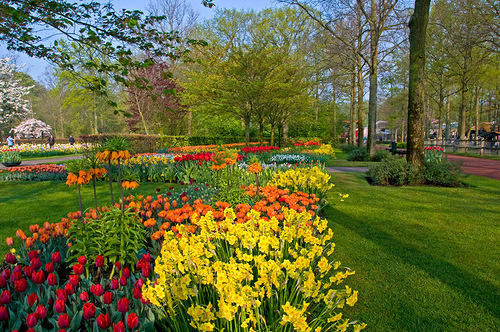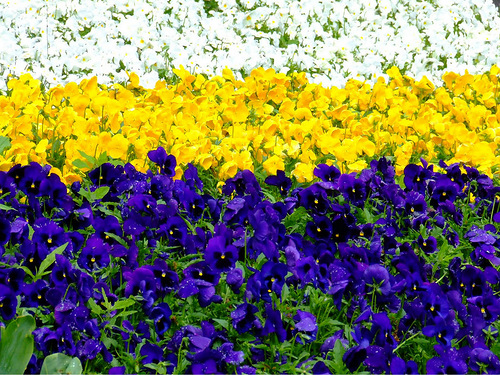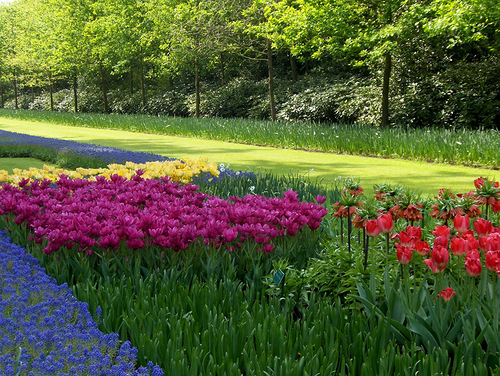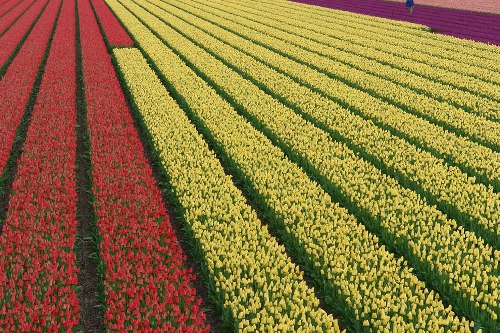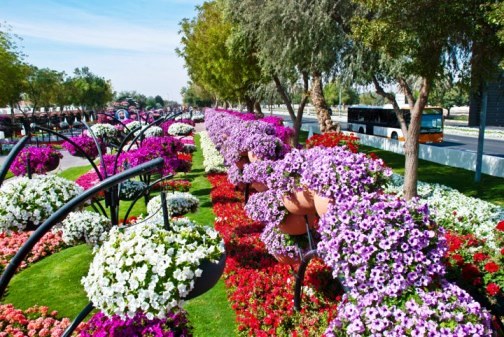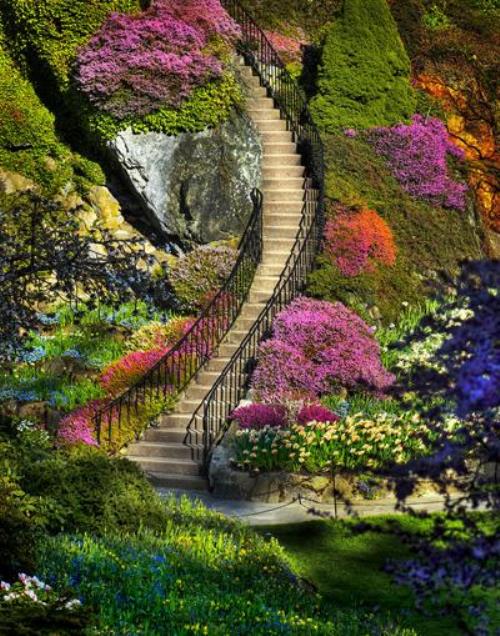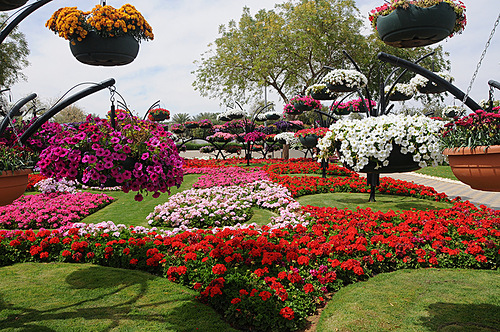Keukenhof the world’s largest flower garden
Keukenhof the world’s largest flower garden. Keukenhof, known as the Garden of Europe, is situated near small town of Lisse, the Netherlands. Approximately seven million flower bulbs are planted annually in the park, which covers an area of 32 hectares. Keukenhof is open annually from the last week in March to mid-May. The best time to view the tulips is around mid-April, depending on the weather. The garden was established in 1949 by the mayor of Lisse. The idea was to present a flower exhibit where growers from all over the Netherlands and Europe could show off their hybrids – and help the Dutch export industry (the Netherlands is the world’s largest exporter of flowers). Keukenhof has been the world’s largest flower garden for over fifty years.
GREAT GARDENS OF THE WORLD
The first gardens planted for pleasure rather than to supply food were probably planted about 3,000 ВС in Mesopotamia (modern Iraq) at the time when the first cities were built. All we know about ancient gardens comes from surviving art, writing, and other historical records. The Chinese emperor Shen Nung compiled a work on herbs around 2,800 BC. Wall-paintings at the Palace of Knossos on the island of Crete which date from around 2,200 BC show lilies, irises, rock roses, and other flowers.
Early gardens were often associated with religion. In ancient Egypt, Persia, Greece, and Italy, the gods were thought to walk in sacred groves of trees, and temples and shrines were usually surrounded by gardens. In the Old Testament of the Bible, Adam and Eve lived in the Garden of Eden, and God himself was said to walk in the garden in the cool of the evening. In the holy book of Islam, the Koran, paradise is a garden.
In China and Japan, nature itself was the god to be worshiped, and gardens were carefully arranged miniature worlds where people could reflect upon their place in the order of things.
The ancient Egyptians left detailed records of their gardens on wall-paintings and in their form of picture writing. Egyptian gardens had orchards of grape vines and fig trees, walks lined with date palms, tamarisk and acacia trees, pools covered with lotus, and vegetable and flower beds. A tomb-painting dating from 1420 BC shows gardeners watering with buckets, pruning trees, and using garden tools remarkably similar to some used today. The earliest surviving plan of a large garden, made about 1400 BC, shows a house in the city of Thebes surrounded by a formal garden of enclosed spaces, tree-lined walks, and four pools with water-birds.
Among the Seven Wonders of the Ancient World there were the Hanging Gardens of Babylon. These were probably built by King Nebuchadnezzar II in about 600 BC and were square, with sides about 120 meters in length. They did not actually hang, but rose into the air in a series of terraces formed one above another, each narrower at the back than the front, so that the whole formed the shape of a pyramid. Vast stone beams and stone pillars were used as supports, and the floors of the terraces were made waterproof with reeds and bitumen, or pitch, to prevent moisture from oozing downwards. Soil was spread on the terraces, and trees and flowers were planted in it. The whole garden was irrigated by pumps with water from the Euphrates River.
The ancient Persians, whose empire flourished between 550 and 330 BC, planned gardens with many avenues of trees, and thought it especially beautiful to have a long chain of pools in which fountains played.
The Greeks had a very different civilization from those mentioned above, poorer sun, and much less water. The people planted many orchards, and public gardens were popular in the crowded cities. The Greek philosophers, such as Socrates and Plato, taught in public gardens and sacred groves of trees.
The Romans planned their gardens carefully, sometimes leveling hills, making artificial ones, building terraces and digging lakes. Within the gardens were stone ornaments, vases and urns, and window-boxes and plants in tubs were normal decorations. After the fall of the Roman Empire the gardens of the followers of Islam spread from North Africa and modern Turkey, to India in the east, and to Moorish Spain in the west. Water and shade were important in Islamic gardens, as were the formal arrangement of flower beds which were copied into rugs and carpets. The palace of the Alhambra in Spain has a wonderful garden typical of Moorish taste.
In Christian Europe, after the fall of the Roman Empire, it was left to the monks to continue the art of gardening in their monasteries, and examples of their skill are still to be found in the Vatican Gardens of the Pope. In the Middle Ages, gardens were confined to the church and monastery cloister and very small castle gardens, where fruits, vegetables, and vines were grown. By the 15th century, in the new order and relative security of the Renaissance, castles were not needed simply to defend the people who lived there. Castles became fine country houses. The ancient idea of a garden as an outdoor room developed again. Gradually an Italian style of garden was developed with long walks bordered by small trees, the branches of which intertwined overhead. The flower beds were laid out in patterns.
The French were influenced by Italian garden design, and took the idea of designing a garden as if it were a room or a work of art much further. Gardens became very large, with long views expressing the French king Louis XIV’s desire to control most of Europe.
The gardens of the Palace of Versailles were designed by Andre Le Notre, a landscape architect who worked for Louis XIV for 40 years. They are a masterpiece of layout and design. Trees, shrubs, and other plants were all fitted into a pattern, and there were magnificent fountains and cascades, very often lit up at night.
The Dutch of the Netherlands and the Flemings of Belgium also liked rather formal gardens, laid out in definite patterns. They were fond of topiary, the art of clipping small trees or shrubs into formal shapes. As there were many canals in their countries, long stretches of water were often part of the design, all Dutch ships leaving for foreign ports were told to bring back seeds and bulbs of interesting plants, or the plants themselves. Some of the first botanical gardens were started in this way in Holland.
Although Britain has borrowed many ideas about gardens from other countries, the English garden has become a special garden style in its own right. Early English gardens such as Hampton Court near London, with Tudor gardens and a maze, were formal outdoor rooms. Queen Mary’s Dutch husband William III brought the influence of the clipped Dutch style, seen at Blenheim Palace in Oxfordshire. The garden designers of the 16th century, such as William Kent and Lancelot Brown, favored a completely natural garden. By making a gentle rise and fall in the land, clearing the hollows and planting the hills, these designers created many different views. Humphry Repton (1752–1818), a follower of Lancelot Brown, built formal gardens near houses and informal ones away from them.
Early North American gardens tended to be neat and formal, which appealed to people trying to make an ordered life on the frontier. In Australia and New Zealand, early gardens were imitations of those at “home” in Britain, but the wonderful variety of native plants led to the development of “native” Australian and New Zealand gardens.
Kinds of Garden
There are many kinds of garden: gardens grown around houses; window-box gardens; indoor and greenhouse gardens; garden allotments for vegetables; market gardens; local and national parks; historical gardens open to the public; botanical gardens; and other special places which grow and breed plants.
Miniature gardens delight children of all ages. They are usually made in a seed tray and last for only a few days, but if a slightly deeper container, such as gravel tray or sturdy wooden box, is used, normal plants can be grown and the project becomes more exciting. If it is planned carefully, the garden can last for many years, needing only an annual sort out, much like any other garden.
Keukenhof the world’s largest flower garden
keukenhof.nl
